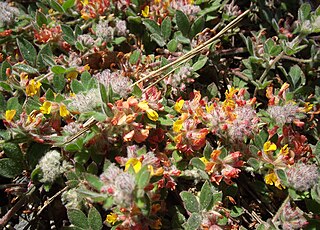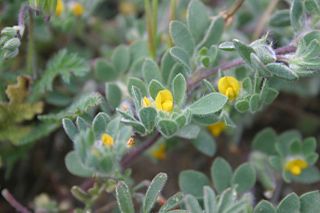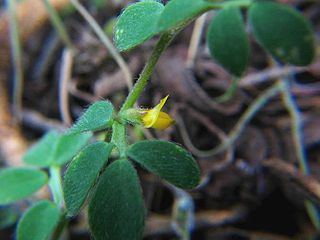Astragalus monoensis is a rare species of milkvetch known by the common name Mono milkvetch. It is endemic to the open pumice plains of central Mono County, California.

Astragalus shevockii is a rare species of milkvetch known by the common names Little Kern milkvetch and Shevock's milkvetch. It is endemic to Tulare County, California, where it grows in the High Sierra, generally on granite-based soils in Jeffrey pine forests.
Astragalus subvestitus is a species of milkvetch known by the common name Kern County milkvetch.
Chorizanthe breweri is a rare species of flowering plant in the buckwheat family known by the common names San Luis Obispo spineflower and Brewer's spineflower. It is endemic to California, where it is known from about twenty occurrences in the Central Coast Ranges of San Luis Obispo and far southern Monterey Counties. It grows in the chaparral and woodlands of the range, generally on serpentine soils. This small plant produces decumbent stems extending along the ground and sometimes growing upright to a maximum length of about half a meter. The herbage is mostly reddish in color and somewhat hairy. The inflorescence is a cluster of flowers, each surrounded by six hairy reddish bracts with hooked tips. The flower itself is only about 3 millimeters wide and is white to red and hairy.

Hoita strobilina is a rare species of legume known by the common name Loma Prieta leatherroot, or Loma Prieta hoita. It is endemic to California, where it is known from occasional occurrences in the San Francisco Bay Area. It grows in chaparral and woodland habitat in the local mountains, often on serpentine soil. This is a perennial herb growing erect, approaching a meter in maximum height. The large leaves are divided into three leaflets each up to 8 centimeters long and lance-shaped to nearly round. The herbage is generally glandular and hairy. The inflorescence is a raceme up to 13 centimeters long containing many pealike flowers. Each flower is purple, sometimes with white parts, and one to two centimeters long. The fruit is a dark brown or black, hairy, veiny legume pod.

Acmispon argophyllus, synonym Lotus argophyllus, is a species of legume native to California and northwest Mexico. It is known by the common name silver bird's-foot trefoil or silver lotus.

Acmispon cytisoides, synonyms Lotus benthamii and Syrmatium cytisoides, is a species of legume native to California. It is known by the common names Bentham's broom and Bentham's deerweed. It is endemic to central California, where it occurs along the Central Coast and into the coastal mountain ranges. It grows in oceanside habitat and inland on slopes and in canyons. It is a mat-forming or spreading perennial herb lined with leaves each made up of a few oval leaflike leaflets up to 12 mm long. The inflorescence bears up to 10 dull pinkish dark-veined flowers, each just under 1 cm long.

Acmispon dendroideus, synonym Syrmatium veatchii, is a species of legume native to California. It is known by the common name island broom. It is endemic to the Channel Islands of California, where it grows on coastal bluffs and cliffs. It is a spreading perennial herb or erect shrub approaching 2 meters in height. It is hairless to hairy and gray-green in color. The branches lined with leaves each made up of a few oval leaflike leaflets up to 1.5 centimeters long each. The inflorescence bears up to 10 yellow pealike flowers, each roughly a centimeter long and fading red as they age.

Acmispon grandiflorus, synonym Lotus grandiflorus, is a species of legume native to western North America. It is known by the common name chaparral bird's-foot trefoil.
Acmispon haydonii, synonyms Lotus haydonii and Syrmatium haydonii, is a species of legume native to California It is known by the common names pygmy lotus, rock bird's-foot trefoil and Haydon's lotus.

Acmispon heermannii is a species of legume (Fabaceae) known by the common names Heermann's bird's-foot trefoil and Heermann's lotus. It is native to the coastal plains, canyons, and mountains of California and Baja California, where it is known from several types of oceanside and inland habitat. It is a mat-forming perennial herb spreading straight stems along the ground. It is lined with leaves made up of several hairy oval leaflets. The inflorescence is a cluster of 3 to 8 flowers each up to about a centimeter long. The petals are yellow, often with dark lobes. The fruit is a curved, beaked legume pod.

Acmispon brachycarpus is a species of legume known by the common name foothill deervetch. It is native to western North America from Idaho to Texas to northern Mexico, where it is known from many types of habitat. It is an annual herb spreading upright or taking a clumpy or matted form. It is lined with leaves each usually made up of four hairy, somewhat fleshy leaflets each up to about 1 cm long. Solitary yellow, pea-like flowers appear in the leaf axils. The fruit is a legume pod variable in size and shape.
Acmispon junceus, synonyms Lotus junceus and Syrmatium junceum, is a species of legume native to California. It is known by the common names rush broom and rush deervetch. It is endemic to California, where it is known from the northern and central coast and the coastal mountain ranges. It can be found from beaches inland to serpentine slopes and chaparral. It is a hairy, prostrate or spreading perennial herb lined with leaves each made up of small oval leaflets. The inflorescence bears up 8 yellow pealike flowers each up to about a centimeter long. The fruit is a small beaked legume pod.

Acmispon parviflorus, synonym Lotus micranthus, is a species of legume. It is known by the common name desert deervetch. It is native to western North America from British Columbia to southern California, where it is known from many types of habitat. It is a hairy to hairless annual herb lined with leaves each made up of small oval leaflets. Solitary flowers appear in the leaf axils. Each is an ephemeral pinkish pealike bloom under a centimeter long. The fruit is a narrow, hairless, wavy-edged legume pod up to about 2.5 centimeters long.
Acmispon prostratus, synonyms Lotus nuttallianus and Syrmatium prostratum, is a species of legume native to California and northwestern Mexico. It is known by the common names beach lotus, Nuttall's lotus, and wire bird's-foot trefoil. It is native to Baja California and just into San Diego County, California, where it is a resident of coastal habitats, such as beaches and bluffs.

Acmispon maritimus, synonym Lotus salsuginosus, is a species of legume native to Arizona, California and northwestern Mexico. It is known by the common name coastal bird's-foot trefoil. It grows in many types of mountain, desert, and scrub habitat, not necessarily near the coast. It is an annual herb quite variable in morphology, from petite to bushy, hairless to roughly hairy, and prostrate to erect in form. The slender stems are lined with leaves each made up of pairs of leaflets variable in shape and size. The inflorescence is a small array of 1 to 4 yellow flowers, each up to a centimeter long or so. The elongated flower corolla emerges from a tubular calyx of sepals. The fruit is a legume pod up to 3 centimeters long. Laboratory studies have shown this species, which occurs in wildfire-prone habitat such as chaparral, to have an increased rate of seed germination after exposure to heat.

Phacelia stellaris is a rare species of flowering plant in the borage family, Boraginaceae, known by the common names star phacelia and Brand's phacelia.
Rupertia hallii is a species of flowering plant in the legume family known by the common name Hall's California tea, or Hall's rupertia. It is endemic to California, where it is known only from a small section of the northern Sierra Nevada foothills on the border between Butte and Tehama Counties. It is a perennial herb approaching a meter in height with slender, leafy branches. The leaves are each made up of three lance-shaped or oval, pointed leaflets measuring up to 9 centimeters long. The inflorescence is a clustered raceme of several whitish or yellowish pealike flowers. Each flower has a tubular calyx of sepals and a corolla spreading to about a centimeter in width. The fruit is a hairy, gland-speckled legume around a centimeter long.

Acmispon wrangelianus is a species of legume native to California and Oregon in the southwestern United States. It is known by the common names Chilean bird's-foot trefoil and Chile lotus. Despite its common name, it is not from Chile. It can be found in many types of habitat, including disturbed areas. This is a hairy, prostrate annual herb. Its slender branches are lined with leaves each made of generally four small leaflets. The inflorescence is composed of a solitary yellow pealike flower around a centimeter wide. The fruit is a legume pod one to two centimeters long.

Ottleya strigosa, synonyms Lotus strigosus and Acmispon strigosus, is a flowering plant in the pea family (Fabaceae), native to the southwestern United States and northern Mexico. It is known as stiff-haired lotus or strigose bird's-foot trefoil.














